An update to my original 1986 release tuned specifically to the Tandy Color Computer 3.
|
The History and Evolution of Donut Dilemma
1984 - TRS-80 Model 1 Version
I originally created Donut Dilemma in 1984 for the Radio Shack TRS-80
Model 1. This was my 6th commercial grade game released back when I was
a young teenager still in High School.
Written in Z-80 Assembly Language using a 32K (home hacked) cassette based system using Radio Shack's EDTASM
Editor/Assembler, I consider this to be my best programming effort for
this machine and was comparable to some of the best games available for the TRS-80 at the time.
The idea for Donut Dilemma was based on our family business in the 80's
when we owned and operated a small Donut Kiosk at a local
Shopping Mall... ironically next door to a Tandy Electronics
store!
We had a
specialized machine which automated the process of making and cooking
the Donuts. Every day, we made a batch of dough in a large bowl
which we poured into one end of the machine. The machine would then
plunger a pre-measured amount into the familiar donut ring
shape and into the hot cooking oil. A series of guides would move the
floating donuts, cooking one half then flip them over to cook the other
half until eventually lifting them out of the hot oil via a
conveyor belt and into a rotating cooling tray, ready to be bagged and
sold.
Occasionally, things would go wrong and we had to stop the machine to remove the mangled donuts before resuming.
It was these moments that led me to the revelation that this had the
hallmarks of a great and original game idea and so Donut Dilemma was
born!
The name of the character you controlled was Antonio which was based on my father, Antoni.
1986 - TRS-80/Tandy Color Computer Version
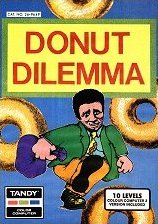 By
the end of 1984, I had transitioned to the Tandy Color Computer with
its high resolution color graphics. In 1986, I had decided to recreate a
version of Donut Dilemma for this machine with plans to pitch the game
to Tandy to sell the game in their stores. By
the end of 1984, I had transitioned to the Tandy Color Computer with
its high resolution color graphics. In 1986, I had decided to recreate a
version of Donut Dilemma for this machine with plans to pitch the game
to Tandy to sell the game in their stores.
After
6 months of
development time, I began looking for a distributor and in 1987, I had
success with Tandy offering to sell the game via their 750 stores
Australia wide. Tandy provided me with an official Tandy Catalogue
number (26-9649) and I manufacturered the packages for Tandy. I
designed the artwork, wrote the manual, arranged the tape duplication
and wrapped each in a clear plastic ziplock bag.
This was available
on cassette with a CoCo 1&2 version on one side and a slightly
modified CoCo3 version that supported the higher clock speed and
modified colors on the flip side of the cassette.
The original CoCo
1&2 version used a new technique I discovered to coerce an
additional 2 colors from the CoCo's 4 colors (red and blue) utilizing a
method of horizontal color striping to generate these 2 extra PAL
artifact colors on a standard PAL CRT TV. This worked well here in Australia in the 80's but doesn't work properly on a US NTSC TV.
Donut Dilemma sold 3400 copies via Tandy in Australia and was my most successful game.

TITLE PAGE
|
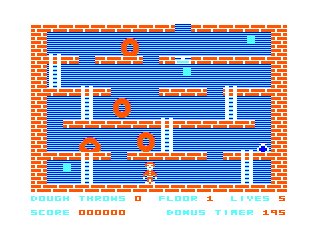
FLOOR 1
|
2008 - PC Version
The information I have on this version is rather thin
but a version of Donut Dilemma was being created by a pair of
experienced game designers in the PC arena as a fun sideline project.
One of the developers had grown up here in Australia having been a fan
of the original TRS-80 Model 1 version back in his younger days.
A real shame it was never finished because the artwork and animation was top notch.

The author even started but not finished a LCD "pocket" style version.
2013 - The Maximite
In 2013, I recreated Donut Dilemma on a small kit computer designed here in Australia called The Maximite. It was a small PIC32 based computer created by Geoff Graham and originally
presented in
the Australian electronics magazine, Silicon Chip (March-May 2011). It
ran a very powerful Basic created by the designer and was very fast.
Donut Dilemma on the Maximite was written entirely in Maximite Basic and ran just as fast as the Assembly Language Color Computer version. It featured 240x216 graphics in 8 colours with 8 bit Amiga MOD format sound effects. It contained all 10 levels from the Tandy Color Computer version and supported the Nintendo Nunchuk and Atari style controllers.

TITLE PAGE
|
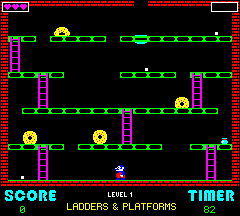
LEVEL 1
|
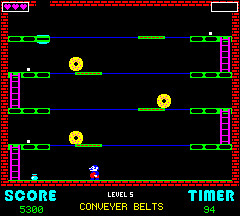
LEVEL 5
|
2014 - The Microbee
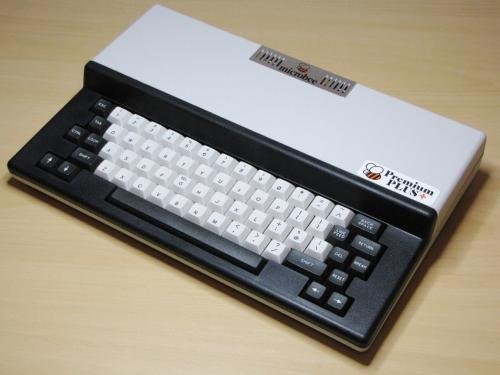 In
2014, Mark McDougal, creator of various transcodes to the Tandy Color
Computer (Apple II version of Lode Runner, Taito's Space
Invaders, ZX Spectrum game of Knight Lore) had asked me if I would be
interested in having my original TRS-80 Model 1 version of Donut
Dilemma converted to run on the Australian computer system, The
Microbee. In
2014, Mark McDougal, creator of various transcodes to the Tandy Color
Computer (Apple II version of Lode Runner, Taito's Space
Invaders, ZX Spectrum game of Knight Lore) had asked me if I would be
interested in having my original TRS-80 Model 1 version of Donut
Dilemma converted to run on the Australian computer system, The
Microbee.
I agreed and sent him the original Z-80 source code and within a week had it running as a perfect copy of the original.
The Microbee had a lot in common with the TRS-80 such as a Z-80 CPU and
the ability to redefine the character set to match the TRS-80's low
resolution graphic characters.
You
can see by the screenshots below that the Microbee version looks just
like the TRS-80 Model 1 version. Thanks to Alan Laughton for the
screenshots.
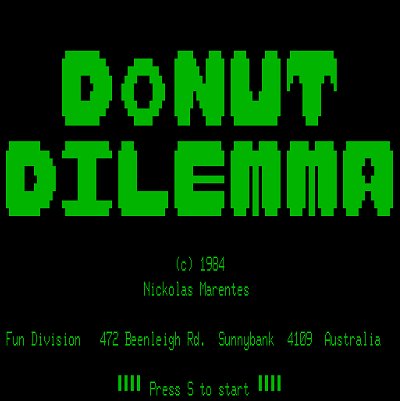 |
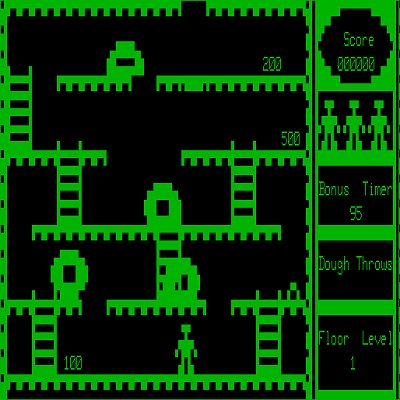 |

2019 - Tandy Color Computer 3 Update
This is a long overdue update to the original Donut Dilemma created over 30 years ago for the Color Computer.
I had released a slightly enhanced version for the Color
Computer 3 with improved colors and faster operation to satisfy Tandy's
request it be CoCo3'ized but I have had many ideas over the years to improve it in areas such as
gameplay without changing it too much from the original.
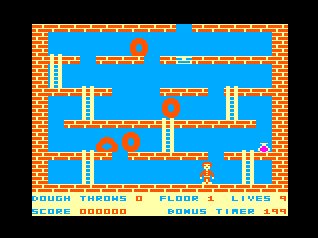
FLOOR 1
|
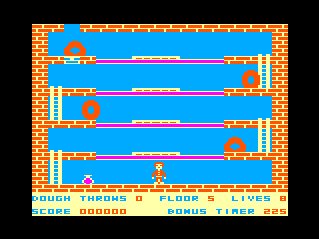
FLOOR 5
|
Here is a list of improvements I have done...
- JOYSTICK CONTROL
- Removed the awkward keyboard control of the original and replaced it with joystick
control. Back in 1986, I didn't know how to read the Color Computer
joystick port from Assembly Language. Also, back then my keyboard
control skills were far better but over time, my dexterity has been somewhat
reduced. (read...I'm getting old!)
- BLACK BORDER
- Removed the white border which was available on all CoCo games using
a graphics screen (or the green border if using the other colorset).
This border color could not be turned off or changed on a standard
Color Computer 1 and 2 using the Motorola 6847 Video Generator. The
Color Computer 3 could but
only when running a GIME chip graphics mode. So I thought that if I
could modify Donut Dilemma to open a GIME mode that has the same
resolution and number of colors (4) as the VDG mode, the code would not know the difference and function
normally. Once in a GIME mode, I could change the border to black
(or any of the 64 colors available). It worked perfectly and
wished so many early games of the time would have done the same.
- GAME TIMING - In activating the higher clock speed of the Color Computer 3, this put the game out of balance
in certain areas. This made some parts too hard and frustrating to play
and so I adjusted these areas to be timed more closely to the original
timings while retaining the extra speed in areas where it was needed.
- RGB AND CMP - Supports the RGB and CMP palettes correctly.
- MORE FUN
- Adjusted the game to be more fun to play to a wider game playing
audience of varying skill level. I've removed the practice mode of the
original (it gave unlimited lives) because that's all that people chose
but increased the number of lives the game starts at to 9 as well as tune the game to be easier to play.

|